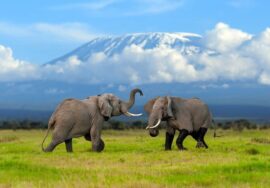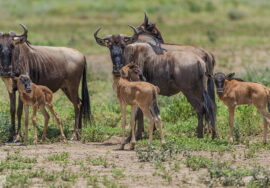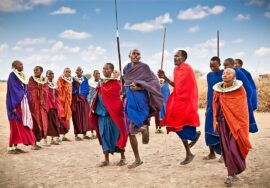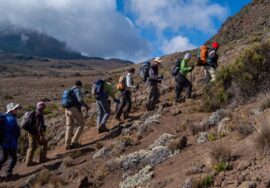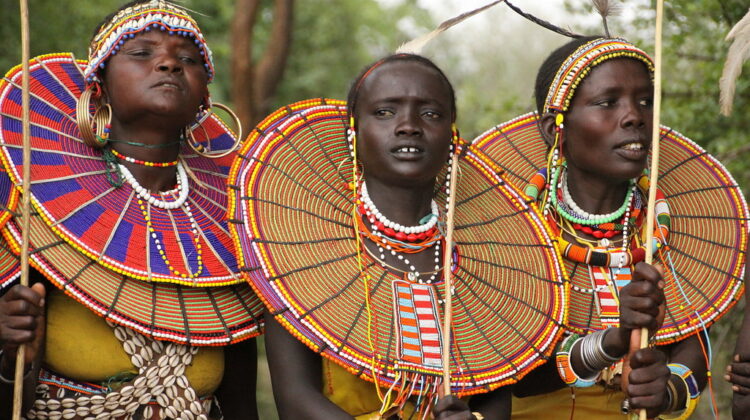
How Many Tribes in Tanzania?
How Many Tribes in Tanzania? An Insight into Tanzania’s Rich Tribal Heritage. With more than 100 different ethnic groups and tribes, Tanzania is known for having a lot of different cultures. Most of Tanzania’s tribes are Bantu, and about 95% of the country’s people are from these groups.
The other groups are made up of people who speak Nilotic and are descended from native hunters and gatherers. A small group of Tanzanians are of Arabic and Indian descent. They mostly live along the coast, in Dar es Salaam and Zanzibar.
A quick look at the past
The Khoisan-speaking hunter-gatherers are thought to have been the first people to live in Tanzania and are the ancestors of all the tribes that live there now. Over many hundreds of years, many different groups, mostly Bantu-speaking people from West and Central Africa, moved into the area. They taught people how to work with iron and learn new farming techniques, which had a big effect on the way tribal groups lived in Tanzania.
Kenya’s Most Important Tribes
Though most of them live in towns, some tribes in Tanzania still live the old way. Many groups live together in cities and some other places, and people there tend to live more modern lives. Even though they live in normal houses with people of other faiths and tribes, they still think of themselves as part of their tribe.
These are the main groups in Tanzania:
In the Sukuma
The Sukuma are Tanzania’s biggest ethnic group. They mostly live in the northwest of the country, in the administrative districts of Mwanza and Shinyanga. There are also Sukuma people who live in Tabora, Dodoma, and Singida areas.
They are the most powerful and well-known tribes in business and politics, along with the Chagga and small groups of Indian and Arab people.
Although there isn’t a lot of history information about the Sukuma, it is thought that their ancestors came from West African Bantu-speaking groups. They moved to where they are now in Tanzania over the course of several hundred years.
The Sukuma have been farmers for a long time and mostly grow crops and do small-scale farming. The “Bugobogobo,” or snake dance, is one of their most famous dances. It is an important part of many of their spiritual and healing ceremonies.
The Nyamwezi
While the Sukuma are the biggest group of people in Western Tanzania, the Nyamwezi are the second largest. Their name, Nyamwezi, means “people of the moon,” which shows that they have a long history of worshiping the moon.
The Nyamwezi people are thought to have moved to west-central Tanzania in the 1600s. In the early 1800s, the tribe was made up of several countries, such as Unyanyembe, Ulyankhulu, and Urambo.
Unyanyembe had a lot of power because it ruled Tabora, a major trading city, and was friendly with the Arabs of Zanzibar. During their past, the Nyamwezi people traded and explored over long distances.
When the Nyamwezi lived in the past, ancestral powers were very important to daily life. People thought that their ancestors could have a good or bad effect on the living, and they did many rituals and worship practices to make these ghosts happy.
The Chagga
The Chagga are a Bantu ethnic group from the Kilimanjaro Region of Tanzania. They are also known as Wachaga in Swahili.
They are the third most common racial or ethnic group in the country. Before they were colonized, the Chagga lived on the slopes of Mount Kilimanjaro and were originally organized into independent states.
Before it was taken over by the British, this area was home to a group of Bantu states that were called Chaggaland or Uchaggani in Swahili.
A lot of important people in the Chagga’s past were called “Mangi,” who were their traditional leaders. There are family plots of land called Kihamba where they live. These have been passed down through generations.
The Chagga are a strong group, and Arusha/Moshi is a strong area. There are still people who live in the old-fashioned way, but many others have made beautiful new homes.
The Maasai
In spite of this, the Maasai and a few other groups, like the Hadzabe, still live mostly in the old way. They usually stay together, wear their traditional clothes, and speak their own language even when they go to the city.
People who are Maasai are thought to have come from the Nile Valley in North Africa. Around the 1400s, they began to move south and finally reached what are now Kenya and Tanzania. In the late 17th and early 18th centuries, the Maasai were at the top of their game and controlled most of East Africa.
The group is known for their unique traditions and clothes. They live a semi-nomadic life and depend on herding animals for a living.
The Maasai are easy to spot because of the way they dress (Shuka), the jewelry they wear with beads, and the amazing ways they change their bodies, like cutting their ears and stretching.
The warrior initiation ceremony, called “Eunoto,” is a big part of Maasai culture. It’s when young men become elders and take on new tasks within the tribe.
The Hehe
The Iringa Region in south-central Tanzania is home to the Hehe tribe, who are known for being strong and having strong warrior customs.
In the past, the Hehe were made up of several smaller groups that came together in the 1800s under the leadership of Chief Mkwawa. The main reason for this union was to fight off threats from outside, especially slave traders and European colonists.
People still notice and remember this part of their cultural history.
In terms of their social life and economy, the Hehe people mostly work and take care of animals.
The Gogo
The Gogo are a Central Bantu ethnic group that lives in the Dodoma Region in the middle of Tanzania. They are part of the larger Bantu group of people who moved around Africa between 2,000 and 3,000 years ago.
The past of the Gogo people shows how diverse and lively they are. They are known for their traditional music, which includes the Zeze, a two-stringed instrument, different kinds of drums, and the Ndono, a calabash-made single-string instrument that is one of a kind.
The Haya
The Haya people live in the Kagera region, which is close to Lake Victoria. They have a long and interesting cultural past.
They are also called Wahaya in Swahili, and they are thought to have come from a group of farmers who used iron and spread to other parts of Africa. The Iron Age people shaped the path that led to the Haya people we know today, which makes this very interesting.
Experts think that people made steel, which is a hard metal, as early as 2,000 years ago. This means that these early people were very smart about how to mix metals to make it before most people around the world did.
The mushonge, which are big roundhouses made of mud and thatch, are one of the things that the Haya tribe is named for.
You may have heard of other tribes.
The Zaramo
The Zaramo group lives mostly along the coast of Tanzania, mostly in the area around Dar es Salaam, which is the country’s biggest city. The Zaramo have a strong matrilineal society. Traditional faiths and Islam, which has been common in this area since the 18th century, are mixed together by the Zaramo people.
As farmers and hunters, the Zaramo grow corn, rice, beans, and cassava, which are all basic foods. The group is good at more than just farming. They are also very good at art and craftsmanship.
Some of the artsy things they do are pottery and carving wood. Mdundiko is a type of dance that they also do.
The Makonde
The Makonde people moved to the southern part of Tanzania, mostly in the Mtwara area, from Mozambique.
It is known all over the world that the Makonde people are very good at carving and painting complex designs in ebony wood that look like people, animals, or nothing at all.
In this group, the matrilineal lineage system is very important, meaning that women’s side of the family comes first. The Makonde also have an initiation event once a year called Nguvumali. This is when young boys and girls become adults, and it includes traditional teachings and symbolic rituals.
The Pare
The Pare tribe lives in the northeast of Tanzania. There are two main groups: the Asu and the Chasu. The Pare mountains are perfect for their farming way of life; they are known for having coffee, bananas, beans, and maize.
The Pare people have a unique social system made up of small, independent governments, each with its own hereditary leader. This shows how complicated their government is.
The Ijanja dance is an important part of the culture. It is a traditional performance that uses rhythmic moves and sounds to make an interesting show.
The Makua
The Makua tribe lives mostly in Mozambique, but there are also a lot of them in Tanzania, especially in the Mtwara area.
They have a generally patriarchal society that puts a lot of value on male lineage. The Makua group is known for its weaving. The men make mats, and the women make baskets.
Also, their music and dance are very popular. They use complicated rhythms and songs in their shows.
The Zigua
The Zigua people live in Tanzania’s Tanga region. They are an agriculturally strong group that mostly grows rice, corn, and cassava, and they fish regularly off the coast.
In the past, the Zigua people were very important for trade over long distances along the caravan paths that went from the coast of East Africa to Lake Tanganyika.
Dance and music are very important to the Zigua society and are used in many of their ceremonies and rituals. The “Ukala” dance, which is a hunting dance, is one of these events. The artists use drums, rattles, and other instruments to make rhythmic sounds and chants that hold the audience’s attention.
Tribes Not as Well Known
Hadza and Sandawe were
The Hadza and Sandawe tribes still live as hunter-gatherers. They are believed to be indigenous to Tanzania. These people are known for speaking unique “clicking” languages that are related to the Khoisan languages spoken by the San people in Southern Africa.
Iraqw
The Iraqw tribe lives in the cool mountains of North Central Tanzania. They have kept their unique Cushitic language alive, which is different from the main Bantu, Nilotic, and Khoisan languages spoken in Tanzania. The Iraqw mostly work as farmers, and they grow a wide range of foods using their knowledge of the area’s rich volcanic soil.
Each Tanzanian group brings its own unique history, culture, and way of life to the country. Collectively, they show Tanzania’s wide range of attractions, reflecting an authentically African mix of tribal cultures that not only survive but also thrive in this East African country.


